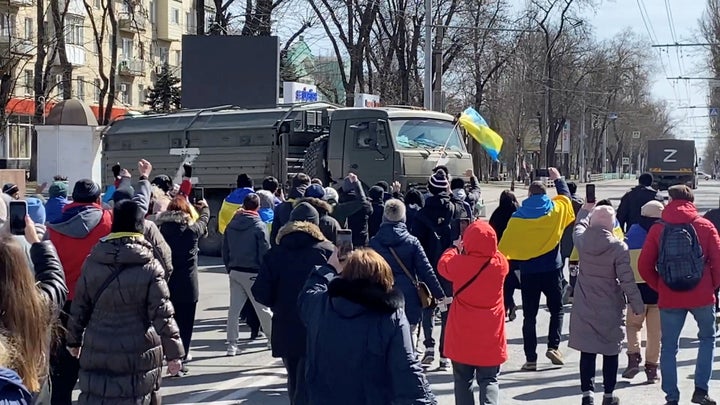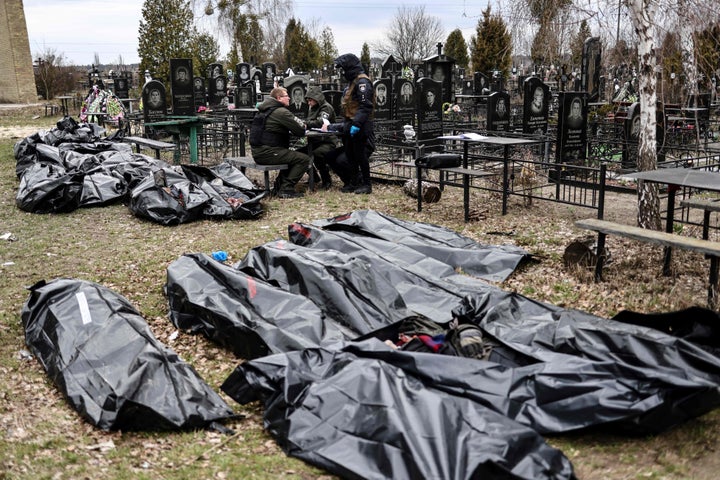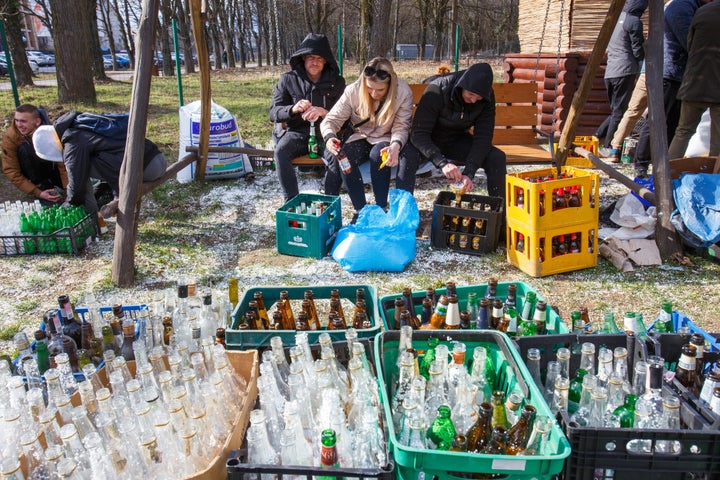Tens of thousands of Ukrainians now live under Russian control in their own country. Civilians in towns and villages from Kherson in the south to Izyum in the east are grappling with crackdowns and, evidence suggests, horrifying war crimes perpetrated by Russian soldiers.
Ukrainians living in Russian-controlled areas are also doing something else: resisting.
Ukraine’s military is leading the country’s effort to vanquish Russian President Vladimir Putin’s forces, which invaded in late February. The U.S. and allies from Europe to the Pacific are funneling arms and sophisticated equipment to these troops.
But Ukrainian civilians are stepping up, too. With little support and training, ordinary people in war-torn, occupied areas are undermining Russia, supporting their country’s counter-offensives, and fueling unity among Ukrainians and international concern for their nation.
“There’s no way to over-exaggerate the extreme bravery that these ordinary citizens are demonstrating,” said Olga Onuch, an associate professor at the University of Manchester.
The civilian resistance to Russia is using time-honored tactics, like daily demonstrations, and foiling occupiers’ plans to consolidate their rule by refusing to cooperate. The resistance is also developing covert, informal efforts to ease humanitarian suffering and hurt Russia’s military capabilities by gathering intelligence and training citizens in small-scale guerilla tactics.
The choices of everyday people can have huge implications for a campaign like the Russian mission, which depends on controlling strategic population centers and challenging a national identity, military experts say. Russia wants the world to believe Ukrainians want its incursion; their resistance proves otherwise.
Some of the most important flashpoints in the conflict in the weeks ahead are connected to occupied towns. Moscow is now focusing on eastern Ukraine, according to national security analysts and Russian leaders. Russia’s forces seek to hold Izyum, a city they captured on Friday that was once home to 40,000 people, and to conquer the nearby city of Slovyansk. If the Ukrainians can thwart that plan, they might quash Russia’s hope of cutting off Ukrainian troops in the country’s eastern regions from reinforcements and supplies.
And in the south, Ukrainians are defying Russia in towns like Melitopol, Enerhodar and Kherson — areas that are integral to Russia’s attempt to limit Ukraine’s access to its coasts, seize the Ukrainian ports of Mykolaiv and Odesa and establish a land corridor between Russian territory and Crimea, the Ukrainian peninsula that Russia took over in 2014.
“While Ukraine’s armed forces are proving themselves capable, no resistance can succeed without an effective auxiliary [of citizens in occupied areas] and underground. The civil element will be essential in the current conflict,” Walter Haynes, a U.S. Army major, recently wrote in an essay for the blog War on the Rocks.

Trapped But Defiant
In March, Kherson became the first large Ukrainian city to fall to Russia. Its residents immediately began protesting against their new rulers, with hundreds gathering in large groups to chant and wave Ukrainian flags. A week later, even bigger crowds demonstrated in occupied Melitopol after Russian soldiers detained the city’s mayor.
"They’re distinctly peaceful — by using the [Ukrainian] national symbols, people are trying to intervene in Putin’s narrative that they would like to be part of Russia or that they don’t have their own state,” said Olga Boichak, a lecturer in digital cultures at the University of Sydney. “Russian media is portraying Ukraine as a failed state, a non-entity. What people are doing is directly contradicting that and showing it is not true.”
Onuch said mass protests are common in Ukrainian history and that citizens know to gather in large main squares near government buildings. Their rallies usually include a diverse sample of the local population: “We can look at the images … it’s not all young people, it’s not all men,” she said.
Two female journalists in Kherson are documenting developments in the city in weekly dispatches for The Guardian (which is protecting their identities), and other locals are raising the alarm about growing problems like shortages of medical supplies.
Through nonviolent methods, Ukrainians hope to prove that Russian control over captured territory is not sustainable.
Some who speak Russian are trying to build a rapport with Russian soldiers to humanize Ukrainians, said Marta Kepe, a senior defense analyst at the RAND Corporation. Melitopol’s mayor, Ivan Federov, challenged the troops who detained him, saying Moscow misled them by claiming that Ukraine hosted Nazis and disrespected World War II veterans. Other Ukrainians are deploying their language skills to demoralize the Russians, telling them they will die in a foreign country or suggesting that food they find in abandoned homes has been poisoned.
Consistent, public resistance in cities like Kherson makes it hard for Putin to stage dubious local elections and claim popular support for Russian meddling in Ukraine, as he has elsewhere in the country, Kepe noted.
“Russia wants the world to believe Ukrainians want its incursion; their resistance proves otherwise.”
Meanwhile, Russian officials are doing little to build trust or sympathy among Ukrainian civilians.
In Kherson, Russians are detaining people in a secret prison and have set up roadblocks that make it impossible for civilians to even visit their loved ones’ graves, according to Elena Kostyuchenko, a respected Russian journalist who traveled to the town for the independent news outlet Novaya Gazeta.
She observed Ukrainians refusing Russian aid and spoke with a local reporter who was kidnapped, beaten and interrogated about who was organizing the pro-Ukraine rallies — treatment that a contact of a local correspondent for The Guardian also experienced.
(Russian authorities have since forced Novaya Gazeta to remove Kostyuchenko’s article.)
Because Russia’s troops mismanaged their supply lines and became desperate for provisions, “looting became endemic” as they advanced through Ukraine, “increasing soldier-civilian contact in all kinds of disastrous ways,” Jason Lyall, a Dartmouth University professor, wrote on Twitter. “Savagery is a function of how the army was recruited, equipped, and deployed.”
On April 3, Human Rights Watch released evidence that Russian forces in occupied Ukrainian areas had committed war crimes, including repeated rape, summary executions and theft. Residents of a recently occupied village in northern Ukraine also told The Washington Post a Russian commander subjected them to beatings and mock executions, attacking them in retaliation for Russian battlefield losses and massacring their livestock.
Moscow seems set on “trying to achieve compliance through intimidation,” Kepe said.

But Russia’s repression is backfiring, sparking more Ukrainian outrage, Kepe and other analysts believe.
The nature of the resistance makes it hard for the occupying troops to wipe it out. When the Russians have targeted infrastructure like TV and radio stations in the occupied regions, Ukrainians have turned to shortwave radio, Kepe said. Much of the organizing relies on internet communications like the Telegram platform, which Russia has not been able to cut off. Volunteers quietly work to help fellow Ukrainians access electricity and inform each other of where supplies can be found.
The movement is “virtually leaderless,” Boichak said, so if Russian troops try to suppress protests by targeting a few prominent individuals, others are likely to immediately replace them.
Russia’s military is willing to escalate, as soldiers showed in Kherson when they used grenades and gunfire to displace rallies. Still, Ukrainians participating in the resistance take brutality as a given, Onuch said: “No one is under any illusion that this is safe.”
Planning For A Fight
In resisting Russia day to day, Ukrainians in occupied territories are preparing for a bigger future clash: the battle to liberate their homes.
“They are starving, with no electricity, no utilities … and they are waiting for the Ukrainian armed forces. They would like to be released,” Mariia Ionova, a member of Ukraine’s Parliament, told HuffPost.
Civilians have shaped the fighting in Ukraine since it began, slowing the Russian advance by tearing down or altering road signs and blocking military convoys with sandbags, crates and even their own bodies. Living under Russian occupation, regular citizens can aid Ukrainian counter-offensives by keeping communities in contact with the Kyiv government, sharing information about Russian logistics and ground conditions, and developing their own fighting and medical capabilities, according to the U.S. Army’s Haynes. (He published his essay on Ukrainian civil resistance in a personal capacity.)
Civilians can also help Ukraine recapture cities by discouraging collaboration between locals and the occupying troops, Haynes continued.
Scott Boston, a senior defense analyst at the RAND Corporation, told HuffPost that Russian intelligence initially failed to identify sympathetic Ukrainians in captured areas. As Ukrainians have publicized civil resistance and military victories, public collaboration with Russia is now even less likely, Boston said.
When battles over occupied areas occur, civilians can use secure communications to keep fellow noncombatants safe, he added. And they can use advice from fellow civilians and Ukrainian authorities to wear down Russian troops, Boichak of the University of Sydney said: creating homemade Molotov cocktails, disarming military vehicles or using whatever they have at their disposal — the way one Ukrainian woman destroyed a Russian drone with a jar of pickled tomatoes.

Boichak noted the morale-boosting impact of Ukraine’s military sharing stories of villagers gathering with shovels to dig trenches. “A lot of it is like that: this understanding that everyone is in it … not everyone needs to be at the battlefront,” she said.
Ukrainians have a recent model for developing a resistance that foils Russia’s aims. In Mariupol, the port city that Putin is now pummeling, Russian-backed militias previously attempted a takeover in the spring of 2014. Activists began organizing small pro-Ukraine rallies and used social media to dispel Russian propaganda, post updates about city life and rally like-minded citizens, most of whom spoke Russian but were convinced of the importance of Ukrainian independence. “That [support] was driven by a sense of Ukrainian national identity as a civic category, not in an ethnonationalist sense” Boichak said.
A month into the occupation, thousands of steelworkers joined police patrols to prevent pro-Russian fighters from establishing an alternative government. And not long afterward, Ukrainian forces reclaimed the city.
Today, regaining occupied territory is a top priority for Ukraine, parliamentarian Ivanna Klympush-Tsintsadze told HuffPost. Anastasia Radina, a fellow lawmaker, said the best way to help people demonstrating against Russia was for Kyiv to deploy advanced equipment like aircraft from other governments.
As the war’s trajectory shifts, civilians are making clear that the conflict is about more than military plans — and that they are more than victims.
“The tragedy of this whole thing is that the Russians miscalculate Ukrainians, the West miscalculates Ukrainians and Ukrainians are using the only tool at their disposal, which is going out on the street and showing that they are wholeheartedly against this occupation,” said Onuch, of Manchester University. “Ordinary people that do extraordinary things always take our breath away.”

